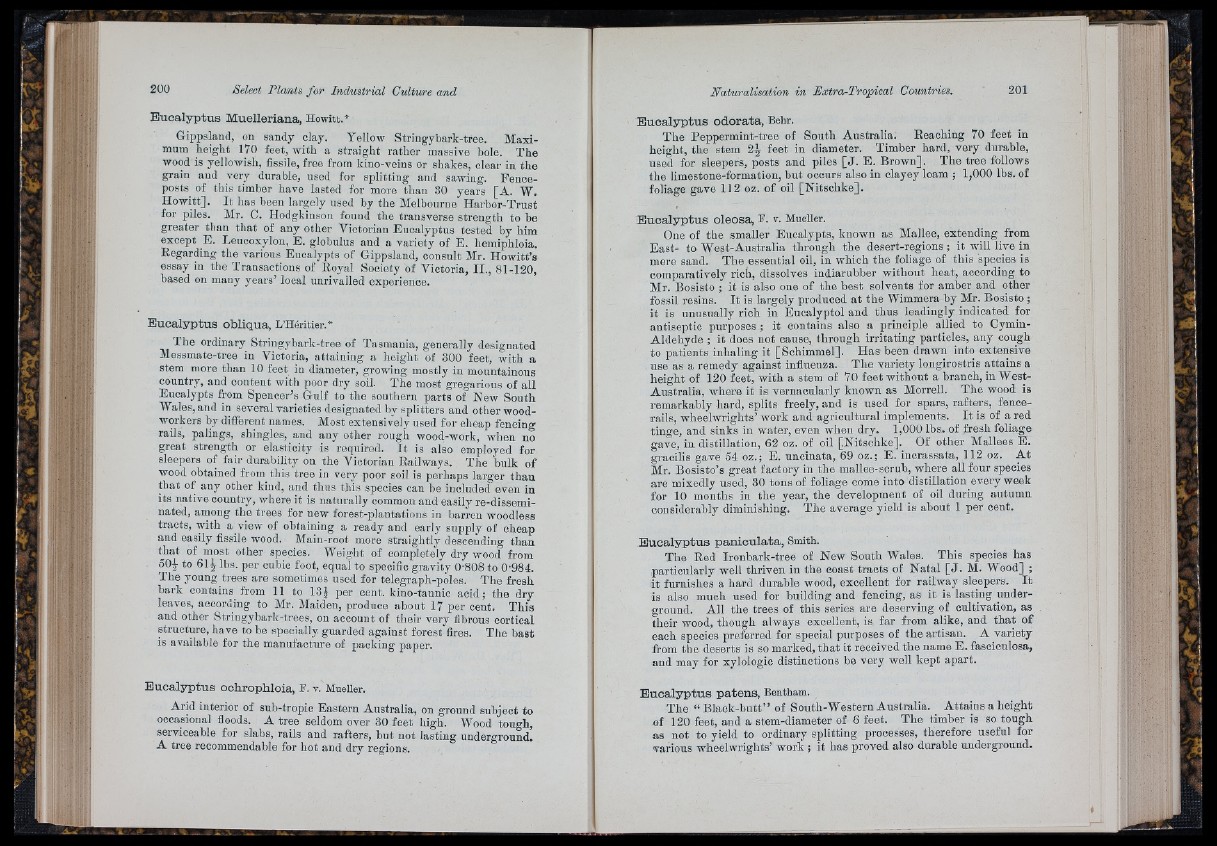
fr l i :
li I
Eucalyptus Muelleriana, Howitt.*
Gippsland, on sandy clay. Yellow Stringybark-tree. Maximum
height 170 feet, with a straight rather massive bole. The
wood is yellowish, fissile, free from kino-veins or shakes, clear in the
grain and very durable, used for splitting and sawing. Fence-
posts^ of this timber have lasted for more than 80 years [A. W.
H owitt]. I t has been largely used by the Melbourne Harbor-Trust
for piles. Mr. C. Hodgkinson found the transverse strength to be
greater tlian th a t of any other Victorian Eucalyptus tested by him
except E. Leucoxylon, E. globulus and a variety of E. hemiphloia.
Regarding the various Eucalypts of Gippsland, consult Mr. Howitt’s
essay in the Transactions of Royal Society of Victoria, II., 81-120,
based on many years’ local uurivailed experience.
Eucalyptus obliqua, L’Héritier.*
The ordinary Stringybark-tree of Tasmania, generally designated
Messmate-tree in Victoria, attaining a height of 300 feet, with a
stem more than 10 feet in diameter, growing mostly in mountainous
country, and content with poor dry soil. The most gregarious of all
Eucalypts from Spencer’s Gulf to the southern parts of New South
Wales, and in several varieties designated by splitters and otlier woodworkers
by different names. Most extensively used for cheap fencing
rails, palings, shingles, and any other rough wood-work, wlien no
great strength or elasticity is required. I t is also employed for
sleepers of fair durability on the Victorian Railways. The bulk of
wood obtained from tbis tree in very poor soil is perhaps larger than
that of any other kind, and thus this species can be included even in
its native country, where it is naturally common and easily re-disseminated,
ainong the trees for new forest-plantations in barren woodless
tracts, with a view of obtaining a ready and early supply of cheap
and easily fissile wood. Main-root more straiglitly descending than
that of most other species. Weight of completely dry wood from
50^ to 61L lbs. per cubic foot, equal to specific gravity 0'808 to 0-984.
The young trees are sometimes used for telegraph-poles. The fresh
bark contains from 11 to 13J per cent, kino-tannic acid; the dry
leaves, according to Mr. Maiden, produce about 17 per cent. This
and other Stringybark-trees, on account of their very fibrous cortical
structure, have to be specially guarded against forest fires. The bast
is available for the manufacture of packing paper.
Eucalyptus ochrophloia, F. v. Mueller.
Arid interior of sub-tropie Eastern Australia, on ground subject to
occasional floods. A tree seldom over 30 feet high. Wood tough,
serviceable for slabs, rails and rafters, but not lasting underground!
A tree reeommendable for hot and dry regions.
Naturalisation in Extra-Tropical Countries. 201
Eucalyptus odorata, Behr.
The Peppermint-tree of South Australia. Reaching 70 feet in
height, the stem 2 J feet in diameter. Timber hard, very durable,
used for sleepers, posts and piles [ J . E. Brown]. The tree follows
the limestone-formation, but occurs also in clayey loam ; 1,000 lbs. of
foliage gave 112 oz. of oil [Nitschke].
Eucalyptus oleosa, F. v. Mueller.
One of the smaller Eucalypts, known as Mallee, extending from
East- to West-Australia through the desert-regions ; it will live in
mere sand. The essential oil, in which the foliage of this species is
comparatively rich, dissolves indiarubber without heat, according to
Mr. Bosisto ; it is also one of the best solvents for amber and other
fossil resins. I t is largely produced a t the Wimmera by Mr. Bosisto;
it is unusnally rich in Eucalyptol and thus leadingly indicated for
antiseptic purposes ; it contains also a principle allied to Cymin-
Aldehyde ; it does not cause, through irritating particles, any cough
to patients inhaling it [Schimmel]. Has been drawn into extensive
use as a remedy against influenza. The variety longirostris attains a
height of 120 feet, with a stem of 70 feet without a branch, in West-
Australia, where it is vernacularly known as Morrell. The wood is
remarkably hard, splits freely, and is used for spars, rafters, fence-
rails, wheelwrights’ work aud agricultural implements. I t is of a red
tinge, and sinks in water, even when dry. 1,000 lbs. of fresh foliage
gave, in distillation, 62 oz. of oil [Nitschke]. Of other Malices E .
gracilis gave 54 oz.; E. uncinata, 69 oz.; E. incrassata, 112 oz. A t
Mr. Bosisto’s great factory in the mallee-scrub, where all four species
are mixedly used, 30 tons of foliage come into distillation every week
for 10 mouths in the year, the development of oil during autumn
considerably diminishing. The average yield is about 1 per cent.
Eucalyptus paniculata, Smith.
The Red Ironbark-tree of New South Wales. This species has
particularly well thriven in the coast tracts of Natal [ J . M. Wood] ;
i t furnishes a hard durable wood, excellent for railway sleepers. I t
is also much used for building and fencing, as it is lasting underground.
All the trees of this series are deserving of cultivation, as
their wood, though always excellent, is far from alike, and th a t of
each species preferred for special purposes of the artisan. A variety
from the deserts is so marked, th a t it received the name E. fasoiculosa,
and may for xylologic distinctions be very well kept apart.
Eucalyptus patens, Bentham.
The “ Biack-butt” of South-Western A ustralia. Attains a height
of 120 feet, and a stem-diameter of 6 feet. The timber is so tough
as not to yield to ordinary splitting processes, therefore useful for
various wheelwrights’ work ; it has proved also durable underground.